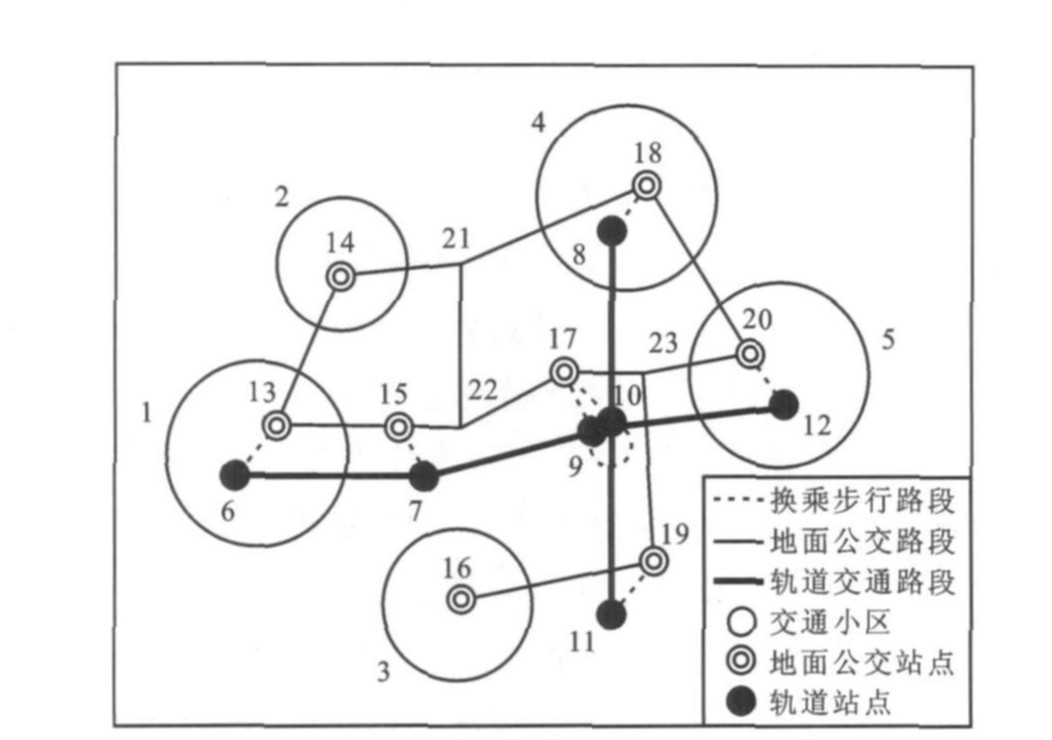-
摘要: 分析了一体化公交网络的交通特性,基于一体化公交出行的路径特点,研究了公交出行时间与出行费用因素对出行阻抗的影响。考虑人流密度对步行速度的影响以及出行费用与时间的换算关系,将公交出行的路段阻抗、节点阻抗与费用阻抗统一换算为时间,建立了一体化公交网络的出行阻抗函数。利用Wardrop均衡原理,建立了一体化公交网络的均衡配流模型,并通过FW算法对配流模型进行求解。计算结果表明:当地面公交线路长度与轨道交通长度分别为57.3、16.2km时,轨道交通线路输送的客流量占总客运量的65.4%,通过换乘进入轨道交通系统的客流量达55.4%。构建合理的一体化公交网络能降低乘客出行总阻抗,提高公交系统运输效率。Abstract: The traffic characteristics of integrated transit network were analyzed, the impacts of trip time and cost on trip impedances were studied based on the path features of integrated transit network. By considering the impact of passenger flow density on walking speed and the conversion relation between travel cost and time, the section impedance, node impedance and cost impedance were transformed to time, and the trip impedance function of integrated transit network was set up. By using Wardrop equilibrium theory, an equilibrium assignment model was established, and the model was solved according to FW algorithm. Computation result indicates that when the lengths of bus transit and rail transit are 57.3, 16.2 km respectively, the ratio of passenger flow volume by rail transit and total passenger flow volume is 65.4%, and 55.4% passengers get access to rail transit system through transfer. So by constructing reasonable integrated transit network, the total trip impedance reduces and the transportation efficiency of transit network improves.
-
Key words:
- traffic planning /
- integrated transit network /
- equilibrium assignment /
- trip impedance /
- rail transit /
- transfer
-
表 1 地面公交和轨道交通的线路
Table 1. Routes of bus and rail
线路 线路走向 轨道 线路Ⅰ 6 7 9 12 线路Ⅱ 8 10 11 地面公交 线路Ⅰ 13 15 17 19 16 线路Ⅱ 13 15 17 20 线路Ⅲ 13 14 18 20 19 16 线路Ⅳ 14 21 17 19 16 表 2 路径长度
Table 2. Route lengths
节点 6 7 8 9 10 11 12 13 14 15 16 17 18 19 20 6 0 33 ∞ ∞ ∞ ∞ ∞ 2 ∞ ∞ ∞ ∞ ∞ ∞ ∞ 7 33 0 ∞ 33 ∞ ∞ ∞ ∞ ∞ 2 ∞ ∞ ∞ ∞ ∞ 8 ∞ ∞ 0 ∞ 33 ∞ ∞ ∞ ∞ ∞ ∞ ∞ 2 ∞ ∞ 9 ∞ 33 ∞ 0 1 ∞ 30 ∞ ∞ ∞ ∞ 3 ∞ ∞ ∞ 10 ∞ ∞ 33 1 0 33 ∞ ∞ ∞ ∞ ∞ ∞ ∞ ∞ ∞ 11 ∞ ∞ ∞ ∞ 33 0 ∞ ∞ ∞ ∞ ∞ ∞ ∞ 2 ∞ 12 ∞ ∞ ∞ 30 ∞ ∞ 0 ∞ ∞ ∞ ∞ ∞ ∞ ∞ 2 13 2 ∞ ∞ ∞ ∞ ∞ ∞ 0 27 21 ∞ ∞ ∞ ∞ ∞ 14 ∞ ∞ ∞ ∞ ∞ ∞ ∞ 27 0 62 ∞ 69 56 ∞ ∞ 15 ∞ 2 ∞ ∞ ∞ ∞ ∞ 21 62 0 ∞ 35 76 ∞ ∞ 16 ∞ ∞ ∞ ∞ ∞ ∞ ∞ ∞ ∞ ∞ 0 ∞ ∞ 33 ∞ 17 ∞ ∞ ∞ 3 3 ∞ ∞ ∞ 69 35 ∞ 0 46 47 32 18 ∞ ∞ 2 ∞ ∞ ∞ ∞ ∞ 56 76 ∞ 46 0 65 33 19 ∞ ∞ ∞ ∞ ∞ 2 ∞ ∞ ∞ ∞ 33 47 65 0 51 20 ∞ ∞ ∞ ∞ ∞ ∞ 2 ∞ ∞ ∞ ∞ 32 33 51 0 表 3 各公交线路的客流量
Table 3. Passenger flow volumes of transit routes
人次·h-1 线路 路段与客流量 轨道 Ⅰ 路段 6-7 7-9 9-12 去程 7 619 7 619 8 091 返程 9 354 11 763 8 086 Ⅱ 路段 8-10 10-11 去程 6 719 8 086 返程 6 710 9 895 地面公交 Ⅰ 路段 13-15 15-17 17-19 19-16 去程 1 447 1 447 429 4 003 返程 1 500 296 429 3 998 Ⅱ 路段 13-15 15-17 17-20 去程 1 448 1 448 799 返程 1 500 295 815 Ⅲ 路段 13-14 14-18 18-20 20-19 19-16 去程 6 354 3 000 2 281 914 4 000 返程 6 420 3 000 2 290 934 4 002 Ⅳ 路段 14-17 17-19 19-16 去程 2 580 665 3 997 返程 2 646 742 4 000 表 4 均衡配流结果
Table 4. Result of equilibrium assignment

-
[1] 四兵锋, 高自友. 城市间旅客列车的票价与流量的灵敏度分析[J]. 北方交通大学学报, 2001, 25(2): 49-53, 69. https://www.cnki.com.cn/Article/CJFDTOTAL-BFJT200102012.htmSI Bing-feng, GAO Zi-you. Sensitivity analysis for the relationship between passenger-ticket price and passenger volume of different sorting trains[J]. Journal of Northern Jiaotong University, 2001, 25(2): 49-53, 69. (in Chinese). https://www.cnki.com.cn/Article/CJFDTOTAL-BFJT200102012.htm [2] 芦群, 刘灿齐. 城市公共交通网络均衡配流模型与算法[J]. 交通与计算机, 2004, 22(4): 3-6. https://www.cnki.com.cn/Article/CJFDTOTAL-JTJS200404000.htmLU Qun, LIU Can-qi. Equilibrium model and algorithm of urban public traffic network[J]. Computer and Communications, 2004, 22(4): 3-6. (in Chinese). https://www.cnki.com.cn/Article/CJFDTOTAL-JTJS200404000.htm [3] 吴祥云, 刘灿齐. 轨道交通客流量均衡配流模型与算法[J]. 同济大学学报: 自然科学版, 2004, 32(9): 1158-1162. https://www.cnki.com.cn/Article/CJFDTOTAL-TJDZ200409008.htmWU Xiang-yun, LIU Can-qi. Traffic equilibrium assignment model specially for urban railway network[J]. Journal of Tongji University: Natural Science, 2004, 32(9): 1158-1162. (in Chinese). https://www.cnki.com.cn/Article/CJFDTOTAL-TJDZ200409008.htm [4] HUANG Hai-jun, TIAN Qiong, GAO Zi-you. An equilibrium model in urban transit riding and fare polices[J]. Lecture Notes in Computer Science, 2005, 3521: 112-121. [5] 程琳, 王炜, 王欣. 可变步长的投影梯度算法与交通网络流量分配[J]. 系统工程学报, 2006, 21(1): 44-48. https://www.cnki.com.cn/Article/CJFDTOTAL-XTGC200601007.htmCHENG Lin, WANG Wei, WANG Xin. Gradient projection with variable step and network traffic assignment[J]. Journal of Systems Engineering, 2006, 21(1): 44-48. (in Chinese). https://www.cnki.com.cn/Article/CJFDTOTAL-XTGC200601007.htm [6] WU Z X, LAM W H K. Transit passenger origin-destination estimation in congested transit networks with elastic line frequencies[J]. Annals of Operation Research, 2006, 144(1): 363-378. doi: 10.1007/s10479-006-0002-2 [7] HAO Ji-xiu, ZHOU Wei, PENG Hu, et al. Elastic bottleneck equilibrium model for rail transit passengers at rush hours[J]. Journal of Transportation Systems Engineering and Information Technology, 2009, 9(3): 93-97. doi: 10.1016/S1570-6672(08)60067-7 [8] 李友好, 刘晓佳, 施其洲. 基于网络的运输通道客运流量分配模型[J]. 交通运输工程与信息学报, 2005, 3(2): 57-62. https://www.cnki.com.cn/Article/CJFDTOTAL-JTGC200502010.htmLI You-hao, LIU Xiao-jia, SHI Qi-zhou. Trip assignment model for transportation corridor based on network equilibrium[J]. Journal of Transportation Engineering and Information, 2005, 3(2): 57-62. (in Chinese). https://www.cnki.com.cn/Article/CJFDTOTAL-JTGC200502010.htm [9] 刘晓佳, 李友好, 施其洲. 运输通道结构配置中的客流量分配模型及算法[J]. 同济大学学报: 自然科学版, 2007, 35(7): 924-928. https://www.cnki.com.cn/Article/CJFDTOTAL-TJDZ200707014.htmLIU Xiao-jia, LI You-hao, SHI Qi-zhou. Model and algorithm research on solving passenger flow allocation in transport corridor[J]. Journal of Tongji University: Natural Science, 2007, 35(7): 924-928. (in Chinese). https://www.cnki.com.cn/Article/CJFDTOTAL-TJDZ200707014.htm [10] 陈义华, 吴国强, 朱玉琴. 多模式拥挤交通网络中的路径分配与收费定价模型[J]. 交通与计算机, 2007, 25(6): 63-66. https://www.cnki.com.cn/Article/CJFDTOTAL-JTJS200706017.htmCHEN Yi-hua, WU Guo-qiang, ZHU Yu-qin. Model of route distribution and toll pricing in multi-model congestion transportation network[J]. Computer and Communications, 2007, 25(6): 63-66. (in Chinese). https://www.cnki.com.cn/Article/CJFDTOTAL-JTJS200706017.htm [11] YU Si-jun, CAO Cong-yong, LIU Ying-shun. A stochastic user equilibrium assignment model for intercity multi-commodity multi-modal networks[C]//ASCE. The Eighth International Conference of Chinese Logistics and Transportation Professionals. Chengdu: ASCE, 2008: 3050-3059. [12] 四兵锋, 赵小梅, 孙壮志. 城市混合交通网络系统优化模型及其算法[J]. 中国公路学报, 2008, 21(1): 77-82. https://www.cnki.com.cn/Article/CJFDTOTAL-ZGGL200801015.htmSI Bing-feng, ZHAO Xiao-mei, SUN Zhuang-zhi. Optimization model and its algorithm for urban mixed traffic network system[J]. China Journal of Highway and Transport, 2008, 21(1): 77-82. (in Chinese). https://www.cnki.com.cn/Article/CJFDTOTAL-ZGGL200801015.htm [13] 韩印, 袁鹏程. 多用户多方式混合随机交通平衡分配模型[J]. 交通运输工程学报, 2008, 8(1): 97-101. http://transport.chd.edu.cn/article/id/200801019HAN Yin, YUAN Peng-cheng. Multi-user and multi-mode assignment model of mixed stochastic traffic balance[J]. Journal of Traffic and Transportation Engineering, 2008, 8(1): 97-101. (in Chinese). http://transport.chd.edu.cn/article/id/200801019 [14] BAILLON J B, COMINETTI R. Markovian traffic equilibrium[J]. Mathematical Programming, 2008, 111(1/2): 33-56. [15] 四兵锋, 杨小宝, 高亮, 等. 基于出行需求的城市多模式交通配流模型[J]. 中国公路学报, 2010, 23(6): 85-91. https://www.cnki.com.cn/Article/CJFDTOTAL-ZGGL201006014.htmSI Bing-feng, YANG Xiao-bao, GAO Liang, et al. Urban multimodal traffic assignment model based on travel demand[J]. China Journal of Highway and Transport, 2010, 23(6): 85-91. (in Chinese). https://www.cnki.com.cn/Article/CJFDTOTAL-ZGGL201006014.htm [16] 罗端高, 史峰. 多用户多方式混合交通均衡变分模型及求解算法[J]. 交通运输系统工程与信息, 2010, 10(5): 110-116. https://www.cnki.com.cn/Article/CJFDTOTAL-YSXT201005017.htmLUO Duan-gao, SHI Feng. Model and solution algorithm formulti-user and multi-mode mixed traffic equilibrium variational inequality[J]. Journal of Transportation Systems Engineering and Information Technology, 2010, 10(5): 110-116. (in Chinese). https://www.cnki.com.cn/Article/CJFDTOTAL-YSXT201005017.htm [17] 梁科. 人行道服务水平的模糊评价模式研究[D]. 武汉: 华中科技大学, 2006.LIANG Ke. Study on fuzzy evaluation mode of levels of service for sidewalks[D]. Wuhan: Huazhong University of Science and Technology, 2006. (in Chinese). [18] 徐猛, 屈云超, 高自友. Frank-Wolfe算法求解交通分配问题: 比较不同流量更新策略和线搜索技术[J]. 交通运输系统工程与信息, 2008, 8(3): 14-22. https://www.cnki.com.cn/Article/CJFDTOTAL-YSXT200803004.htmXU Meng, QU Yun-chao, GAO Zi-you. Implementing FrankWolfe algorithm for traffic assignment problem under different flow update strategies and line search technologies[J]. Journal of Transportation Systems Engineering and Information Technology, 2008, 8(3): 14-22. (in Chinese). https://www.cnki.com.cn/Article/CJFDTOTAL-YSXT200803004.htm -





 下载:
下载:






